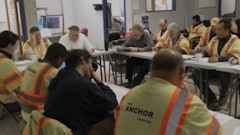
Working with people is one of the best things about construction, and the most challenging! For most of our leadership time we are focused on positive and productive tasks and efforts. Yet, once in a while we find that one employee who, after several corrective efforts, either doesn’t understand the consequences or refuses to comply with our corrective instructions. Discipline then enters the relationship.
I’ve had many contractors and construction leaders ask the following questions:
- “When do you discipline an employee?”
- “How much discipline do you apply before you terminate an employee?”
Both questions are good questions and need good answers. Let me try to address both questions with some solid suggestions that can strengthen your confidence in your disciplining efforts.
First of all, let’s be sure to grasp the importance as to why discipline is important. Discipline should be applied whenever you have an employee whose behavior or performance is detrimental to your company, its productivity or the professionalism of others.
We cannot allow “employee anarchy” to set in, enabling employees to do whatever and whenever they want. Without becoming overly restrictive, we need organization, standardization and compliance in our business if we are to grow upward and onward.
Maintaining a disciplined work culture is also significant because it builds respect within the company. When every employee recognizes that your company has rules and procedures that are critical in maintaining quality, safety, productivity and success you will have a workforce who respects you and will work hard to achieve success.
Herein lies the answer to our first question, When do you discipline an employee? You discipline an employee when he or she is no longer performing or behaving in a manner that is positive or contributing to the overall good of the job being performed — or who is preventing others from the same.
Of course, when an employee first makes a mistake we should be helpful and try to redirect his efforts to being positive and productive. Much of this effort is called “coaching,” and we are called as leaders to do a lot of coaching. This effort may require several corrective actions before the slower learners catch on. Remember, not all employees learn at the same speed.
So, again, when do you discipline an employee? One clue is when you have been consistent and clear in your coaching effort and you know your employee fully understands what you are asking him to adjust or change — yet he doesn’t do it. Whether it’s his inability to make the change or his resistance to making the change, discipline is probably next in store.
What sort of discipline might be in order? This is another good question whose answer primarily rests with you, the contractor. The intensity of the discipline can range from a verbal reprimand to a more serious level that could include a written reprimand with a day or more off from work without pay. There needs to be a progression, moving from a lighter discipline to a “heavier” discipline that clearly points to consequences. The progression and order is totally up to you.
Keep in mind that at all levels of discipline your objective is to “salvage” the employee in trouble. Why? Because it is still less expensive, in most cases, to work with a troubled worker and hopefully turn him around than to train a new employee.
It is important that you include such “hope” for the employee receiving the discipline, reminding him that you really want him to improve, to change and to adapt.
Briefly, consider the levels of discipline below if you do not currently have a formal policy.
Progressive discipline
- Verbal reprimand with direct leader (Be specific)
- Second verbal reprimand with direct leader and next senior leader
- First written reprimand (Kept in employee’s HR file)
- Second written reprimand; time off without pay (Also filed)
- Final written reprimand or termination
There is great flexibility in the steps above. That’s part of the intent, thus allowing the employee more than enough time to consider his situation and make the needed changes in order to remain employed. Remember, you set the steps; just be careful to be consistent with any employee that requires more than an occasional reminder.
The second question raised earlier is worth reviewing now.
- “How much discipline do you apply before you terminate an employee?”
Within the five levels of progressive discipline presented earlier is much effort on your part to influence the employee to make the needed correction. But how long do you go before you must face the reality that perhaps the employee is not going to make it?
Providing disciplinary actions to a worker with a bad attitude might lead you to take a shorter amount of time before removing them from your company. But often, the worker that we discipline can represent the worker who at one time was a promising employee. He might also be the best craftsman you have in the company. Admittedly, many contractors will drag their feet when such an employee is in trouble.
Being consistent here, no matter what the background or expertise of the worker, is of greater importance. As much as it might hurt to really come down on that great skilled employee, for the long-term integrity and respect from your other workers, be consistent in your disciplining efforts.
One last thought about your disciplining effort. As was mentioned before, most of your leadership will be focused on positive and productive efforts. But when you are faced with a need for discipline, keep a few additional tips in mind:
- Do not swear/cuss at your employees…ever!
- If you must confront a bad employee, do it privately, away from your other employees.
- Maintain a low but serious tone of voice.
- Always prepare what you will say; script it if necessary.
- If it is easy for you to “lose it” then take someone with you for the meeting who will kick you under the table if necessary!
- Always follow-up with the employee being disciplined to assure him that you are sincere, not a bully, and reinforcing your hope for him to turn around.
- If the employee “turns around,” forgive and forget in your interactions with them.
- If you must terminate, be only factual about the reason for their dismissal; do not air your emotions!
Having a disciplined workforce may require that you apply some discipline periodically. While the “applying” effort is never fun, remember that this is your very clear proof that everyone is held to the same accountability levels.
Unless an employee commits some offense that is worthy of immediate termination, (i.e. brings a gun to work, threatens another worker, clear discriminatory language, etc.) remember to be methodical. Clearly communicate each step to your problem worker and make clear what the next step of consequences represents. This effort will not only potentially be a wake-up call for the employee but will remind you of your own steps to take.
Good luck in your disciplining. Join the rest of us leaders who also have had to protect our company’s reputation and the attitudes of other workers. Now that I think about it, disciplining a worker deserving of it may be about the best thing I can do as a contractor or leader within my company!




















